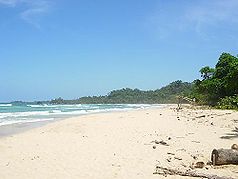Marine National Park Bastimentos Island
| La Amistad National Park | ||
|---|---|---|
| Beach Wizard on the island of Bastimentos | ||
|
|
||
| Location: | Panama | |
| Specialty: | Landscape type: archipelago, mangrove forests, beaches, ocean surface, corals | |
| Surface: | 130 km² | |
| Founding: | 1988 | |
The Marine National Park of Bastimento Island ( Parque Nacional Marino Isla Bastimento ) is a national park in northwestern Panama . It includes a large part of the island of Bastimentos , many small islands and for the most part (11,596 ha) of sea surface.
Flora and fauna
Living in this national park:
- over 300 types of plants, including cedar trees
- 28 species of reptiles or amphibians (17 of which are critically endangered), including four species of sea turtles that lay their eggs on the island's beaches, poison dart frogs , alligators , and caimanee
- 68 species of birds , including frigate birds , hummingbirds , yellow-cheeked amazons
- 32 species of mammals , including capuchin monkeys , two- and three-toed sloths , agoutis
- over 200 species of fish
- Stone and octocorals, among others
Underwater flora and fauna
The visibility was in the best case, of course very different at certain points and depending on the proximity of sandy beaches etc., at 10 m clear / 15 m diffuse vertically and sometimes over 15 m horizontally clear. The underwater world in the shallow water area is dominated by seagrass meadows ( Thalassia testudinum ), in places the grass -forming corals Porites porites and Porites astreoides , and mainly red and brown algae. The majority of the corals are Millepora complanata , some brain corals ( Collophyllia natans , Diploria labyrinthiformis , Diploria strigosa and Diploria clivosa ) can be found, Montastraea sticks ( Montastraea annularis and Montastraea cavernosa ) are found at greater depths. In contrast to the archipelago around Colón, the massive, red-brown hemispherical coral stocks of the Siderastrea siderea , which grow into the low water area, are rather rare in the southern coastal area . They often form typical "mini atolls" with a ring-shaped bulge of living coral polyps and a central dead plateau. There are also Meandrina meandrites and a number of sea urchins ( Echinonetra lucunter ). Porolithon pachydermun (calcareous red algae) overgrows many areas of coral that have died , especially due to the plume of wastewater from inhabited islands. In current areas, the antler coral Acropora cervicornis occasionally forms larger areas, some table corals ( Acropora spicifera or Acropora palmata ) also seem to prefer this habitat. On the entire Caribbean coast, the diversity of species and the quantity of fish has decreased enormously in recent years.
The real gems of the underwater world in the archipelago of the Colón Island are colorful sponges , which are often mistaken for corals. A study by the University of Stuttgart (see Bibliography) provides invaluable assistance in determining this: the yellow sponge ( Mycale laevis ), the red finger sponge ( Amphimedon compressa ), the yellow-brown Xestospongia subtriangulis , the blue-gray Nihpates erecta , the brown sponge with nubs on the surface Icricina strobilina , yellow-green lights Iotrochota birotulata and wine-red Monanchora arbuscula . Vase sponges ( Xestospongia muta ) and funnel sponges ( Ircinia campana ) are relatively rare, but can even be found in shallow water areas . Furthermore, tube sponges such as Callypongia vaginalis and the squat, purple and yellow glowing tubes of Pseudoceratina crassa and Verongula rigida can be found at greater depths .
Environmental protection under water
The study by the University of Stuttgart (see Bibliography) indicates that the reefs in this area were still in relatively good condition at the time, but on the verge of life. This also shows the lack of reefs in front of banana plantations. Pollution from garbage, sewage and freight traffic has increased significantly since then and has tended to intensify since the study. It should also be noted that the stock of starfish and sea cucumbers has almost completely collapsed due to the overexploitation of Asian customers! Many large sea snails (especially Panam. Cambute = Strombus raninus ) are particularly eaten by the local population, are offered to tourists as a specialty and are now also nearing extinction. Contrary to the law, even sea turtle eggs are publicly offered in many markets. In recent years, tourism has become a threat, but also an opportunity for the reef - if they lead to appropriate reactions.
tourism
There is an educational trail . Visitors can watch the turtles lay their eggs in the appropriate seasons . The Isla Bastimentos has several beaches for surfing (including Wizard & Paunch) and from the main island Colón Island by boat taxi is just minutes away.




